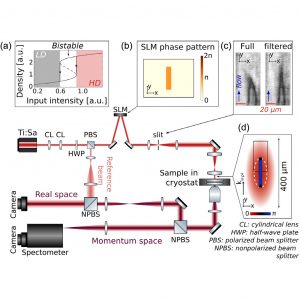Dark-soliton molecules in a polariton superfluid
Experiments performed the Quantum Optics team[1] show that dark solitons in a quantum fluid of polariton quasiparticles can bind together to form a soliton “molecule,” contrary to experiments on other quantum fluids.

Parallel dark solitons pair. On the left the density of the polariton fluid is shown. The solitons are imprinted in the red region and propagate in the bistable region of the fluid reaching a characteristic equilibrium distance, fixed by the dissipative nature of the fluid. On the right the phase of the polariton fluid, showing a phase jump near π across the solitons.
Solitons are localized waves propagating with unchanged shape in a nonlinear medium. Since their first observation in shallow waters, solitions have been observed in many different physical systems. Solitons can be bright, with a localized bump, or dark, with a dip on a homogeneous background. In this work, we use a novel all-optical technique to imprint dark solitons in a type of quantum fluid and find that two dark solitons can bind together to form a “dark-soliton molecule.”
Bright solitons are known to attract or repel each other, but previous work has shown that dark solitons experience only mutual repulsive forces, except in media with non-local long-range interactions. Our work shows this is not always the case: dark solitons can attract one another in media with local interactions as well.
In our experiments, the medium is a quantum fluid of polaritons, quasiparticles composed of a photon coupled to an electric dipole. We show that two dark solitons can be imprinted parallel to each other and bound to form a stable “molecule,” which propagates on the fluid over macroscopic distances.
Our results are a significant advance in the understanding of non-linear phenomena in out-of-equilibrium quantum fluids, and our all-optical technique opens a way to the systematic study of quantum turbulence.

|1] and published on Physical Review X, 10, 041028 (2020)
